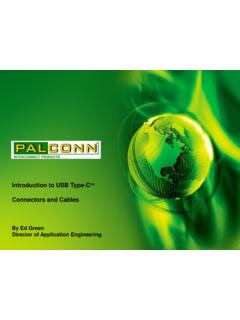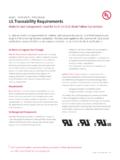Transcription of Eaton Electrical Inc. Aluminum — The Other Conductor Moon ...
1 Aluminum The Other ConductorBy: Bob Yanniello Division Engineer Manager Electrical assemblies Division Eaton Electrical Inc. Avery Creek, NC, USA. Eaton Electrical Cherrington ParkwayMoon Township, PA 15108 United Statestel: Aluminum The Other Conductor Abstract Aluminum conductors have been successfully utilized in the Electrical industry for over 100 years. Electricity is transmitted from the utility power plant to point-of-use meters using Aluminum wiring almost exclusively. The use of Aluminum wiring has been recognized since the publication of the second edition of the National Electrical Code in 1901. Shortages of copper (CU) during the Second World War prompted Electrical equipment manufacturers to expand their offer-ings for Aluminum (AL) for current-carrying conductors.
2 The success-ful application of these materials provides significant evidence that both CU and AL are suitable choices for the conveyance of electric is the most abundant of all metals and is extracted from bauxite. Technical discussions and articles about the use of Aluminum vs. copper have been published in the Electrical industry for many years. The objective of this document is to provide the reader with information by which they are able to make a more informed decision given a choice between the two materials in Electrical the purposes of this discussion, two major classes of Electrical distribution and control equipment will be addressed first, equip-ment utilizing bus bar, such as busway, switchboards, switchgear and motor control centers, and second, equipment utilizing wire or strap windings, such as motors or factors that designers must weigh when deciding between these two materials fall into four primary categories: Mechanical properties Electrical properties Reliability considerations Cost considerationsEach of these areas will be discussed in this document.
3 Page 1 Aluminum The Other ConductorEaton Electrical Cherrington ParkwayMoon Township, PA 15108 United Statestel: Misconceptions What Are The Facts? The following misconceptions have led to the perspective that alumi-num is an inferior Conductor to copper: Misconception #1 Many Electrical equipment manufacturers have completely eliminated AL Conductor options from some of their product offerings, which is evidence that AL is an inappropriate Conductor for some Electrical equipment. Misconception #2 It is common knowledge that AL is a poorer Conductor of electric current because it has a higher resistance than CU. Misconception #3 The public is aware of the problems that resulted during the late 60s and early 70s when the industry introduced AL residential wiring, thus AL must be inferior since it was replaced by CU.
4 Misconception #4 The public knows that AL is less expensive than CU, thus CU must be upon these misconceptions, the common conclusion is that the clear choice between the two materials is Mechanical Properties Technically, the mechanical properties of AL are shear and tensile strength, hardness, and modulus of elasticity. AL does have a lower tensile strength (37%) than CU for the same cross section of material. As will be discussed later, however, a 66% greater cross-section of AL is required to carry the same amount of current as would be required for a CU Conductor , so the larger cross-section of AL approaches the tensile strength of CU for a given reality is that for Electrical applications, the mechanical areas of concern for Electrical conductors are: Ability to withstand the forces imposed under short circuit conditions The effects of thermal expansion and contractionThe classes of industry standards in the that address the design and testing of Electrical distribution and control equipment are Underwriters Laboratories (UL ), The National Electrical Manufacturers Association (NEMA ), and The Institute of Electrical and Electronics Engineers (IEEE).
5 These standards identify criteria for the performance of short circuit withstand testing, and dictate that worse-case product variations are tested. For this reason, users can be assured that product bracing is adequate for the published with-stand capability of the product regardless of the choice of Conductor . This is particularly true for products certified by third parties such as UL, since they provide a legal oversight role to ensure ongoing compliance with manufacturers certification claims. On this basis, users can be assured that both CU and AL product designs meet equivalent bracing thermal storage capacity of Aluminum is cal/gram/ C for CU it is cal/gram/ C. Thus, AL has a thermal storage capacity of over times that of CU. Aluminum wound transformers have a superior thermal storage capacity compared to copper wound units, and they can withstand more surge and overload currents than copper wound units.
6 Pure AL has a coefficient of thermal expansion of x 10 -6 / C vs. CUs of x 10 -6 / C. This would lead users to believe that joints for AL conductors are prone to more fatigue from thermal cycling than CU which is correct, however, manufacturers have connection methods to address this issue. The utilization of spring-type conical washers in bolted joints provides for the proper contact pressures and more than accommodates the thermal expansion difference. Since the melting temperature of AL is well over 600 C, the maximum application temperature of Electrical equipment does not come close to these limits, so material flow contributing to the weakening of Electrical joint pressure is not a copper and Aluminum are subjected to oxidation when exposed to the atmosphere.
7 When applied in Electrical products as bus bars, AL conductors are plated with nickel, silver or tin, thus eliminating the high resistance characteristics of surface oxidation at joints. When utilized as winding materials, as in transformers and motors, conductors are welded, braised or staked-on to penetrate through and Conductor surface oxidation. Concern over AL surface oxidation away from joint areas is not an issue, as when in contact with the air, a hard transparent Aluminum oxide coating quickly forms, which protects the Conductor from further corrosion in most environments. Electrical Properties The Electrical resistivity of Aluminum increases with impurities. ASTM specifications permit a minimum of AL content to be classified as Electrical Conductor (EC) grade AL.
8 At present, the Aluminum producers offer EC grade with a minimum of percent AL. Aluminum 1350 is a common EC grade, with a content of is a misconception that products with AL conductors run hotter than those with CU; such is not the case. Regardless of the material, wherever possible, manufacturers optimize material Conductor content. The industry standards, such as UL cited earlier, provide Electrical equipment design performance criteria. When it comes to current carrying capacity, two criteria are accepted current density in amperes per cross section of Conductor , or temperature rise criteria. For some products, the manufacturers are given the option to utilize either of these criteria, in Other cases, thermal performance is the only criteria. So, regardless of the choice of Conductor material, temperature rise tends to be equal, and manufacturers optimize the Conductor content to meet performance requirements.
9 Products built with Aluminum do not operate at higher temperatures than those built with AL has an Electrical conductivity by volume of 62% of that of CU. Pure AL has an Electrical conductivity by mass of 214% of CU. Combining these conductivity measures with the densities of CU ( ) and AL ( ) yields a to one ratio. The result is that 1 pound of Aluminum has the same conductive capability as pounds of copper. Thus, although the conductivity of copper is better than that of Aluminum , on a per pound basis, Aluminum is over twice as good a Conductor as copper. Where weight is a design consideration, AL is an excellent choice. Where space is a critical limitation, CU may be required. Page 2 Aluminum The Other ConductorEaton Electrical Cherrington ParkwayMoon Township, PA 15108 United Statestel: Since more AL is required by volume than CU for a given ampacity and environment, AL Conductor volume must be increased vs.
10 That for CU, which results in a larger AL Conductor surface area. If the additional space to accommodate the higher volume of AL is acceptable, the increase in Conductor surface area actually produces two benefits. During the conduction of alternating current, a condition known as skin effect occurs. This phenomenon is the tendency of alternating current to distribute itself within a Conductor so that the current density near the surface of the Conductor is greater than that at its core. The greater the surface area of the Conductor for a given ampacity, the more efficient the Conductor utilization will be. Additionally, larger AL cross-section area generally results in wider conductors or more conductors per phase. This increased Conductor size results in more joint contact surface area, which provides for lower current transfer density.














